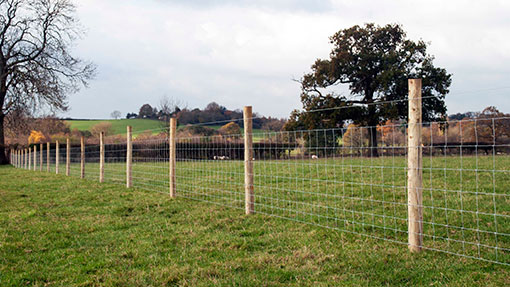Twelve top tips for perfect fencing

Building a stock fence that’s going to survive the rigours of farm life means getting it right first time around.
Fencing manufacturer Tornado has given us a few top tips for how to get your wire tight, your posts straight and which type of wire and staples to pick for the perfect fencing job.
See also: Our latest article on this topic – How to build the perfect livestock fence
1. Guide your posts
Run a single strand of plain wire between your straining posts (situated at either end of the fence line). This will provide you with a straight line to guide the position of your intermediate posts and will also highlight any undulations in the ground. It’s a cost effective way to raise the fence’s overall height, too.
2. Tying-off
To make tying-off around your straining posts easier, strip out the last few vertical wires of the fence. This will give you far more room to work.
3. Avoid over-specified fencing
To save money on your fencing installation, avoid using an over-specified fence. For example, when you want to fence animals out instead of containing them, a fence with a larger mesh may be sufficient.
4. Straining posts
When installing the straining posts for your fence, ensure the struts are long and positioned low. This will create better resistance to hold the post firm and reduce the chances of it falling down in the future.
5. Dig deep
Take the time to make sure your main straining posts are firm as failing to do so will mean you won’t have enough tension along your fence line. Typically they should be dug or driven 1.2m into the ground.
6. Get tension right
Wire fencing is manufactured with a crimp along the line wires to help in the tensioning process. You should tension your fence so that the crimp is about 50% of its original size to make sure the fence is tight, while retaining the overall elasticity of the wire. This will improve the performance of your fence in case of animal impact.
7. Barbed staples
Using barbed staples, rather than plain, to secure your fence to the posts will reduce the chance of them pulling out.
8. High-tensile fencing
Always choose high-tensile fencing. Capable of being strained much tighter than mild steel, it’s easier to erect and is less likely to sag after animal impact. What’s more, it requires fewer posts, so it’s more cost effective.
9. Longer rolls
To minimise the number of joins in your fence line and save time during installation, use longer rolls of fencing. While it might be less easy to handle manually, stock fencing is available in up to 500m lengths.
10. Securing the posts
Don’t drive staples tight against the wire when it comes to securing your fence to the posts. This damages the galvanising on the wire and can reduce the fence’s life.
11. Downward pressure from cattle
To protect your fence from downward pressure from cattle, add two strands of high-tensile barbed wire or one electrified plain wire above the fence.
12. Use a straining clamp
Using a straining clamp when tensioning your fence will ensure even tension across the fence line.
See also: Hand-held post knocker takes headache out of fencing

